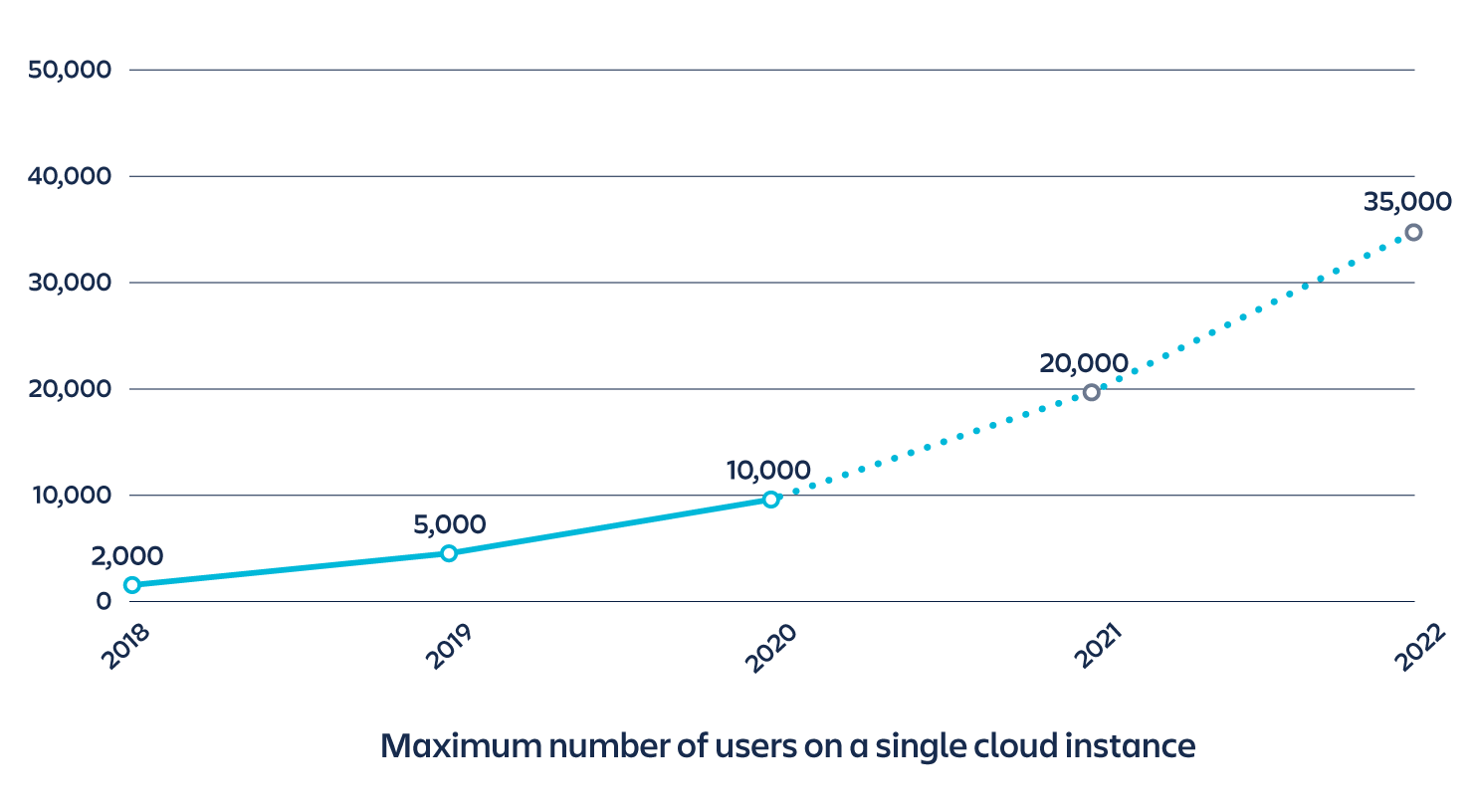Choosing the best cloud migration approach for your enterprise
Two strategies for cloud adoption at scale.
We understand that, due to complexity and scale, enterprises often need considerable planning, research, and support when migrating from Atlassian’s self-managed products to our SaaS offering. Whether you have strict regulatory requirements or need to support an extra-large user base, it may feel like the path to cloud isn’t clear for your organization.
But as you may already know, we’re continuing to invest in our cloud offering in ways that will make it the best choice for many – if not all – of our customers. And we don’t want enterprises to be left out.
The good news is that there is a path forward for our enterprise customers to begin adopting our cloud products now and start reaping their benefits. For those looking to make that move, there are two main options available: taking a gradual approach (by moving individual teams, products, or divisions to cloud over a period of time), or moving all teams to cloud and leveraging unlimited instances in Cloud Enterprise.
A gradual approach
We understand that an immediate, full-scale move to our cloud products may not be in the cards. Whether it’s regulatory roadblocks or just getting organizational buy-in for a move to SaaS – you may currently be facing obstacles that prevent your organization from migrating your entire Atlassian toolset to our cloud products.
A gradual migration approach, done in stages, may be a good solution for those enterprises who are keen to take advantage of the benefits of our cloud products, but who are unable to make an organization-wide move to cloud today. With this hybrid Atlassian deployment strategy, you can keep some of your instances self-managed – either on Server or Data Center – while you move one or many to cloud. This model allows organizations to realize the benefits of cloud in some areas, while maintaining the control necessary to meet certain security or compliance requirements in others.
This approach makes the most sense not only for organizations currently facing roadblocks in a full-scale move to cloud, but also for those with units or teams that operate autonomously and can therefore begin the move to cloud while others stay on self-managed Server or Data Center.
And while administration between multiple platforms can be complicated, we’re committed to making platform improvements – in the areas of user management and security, to begin with – that will make this situation easier. Here are some features in the cross-deployment space you can expect from us to help you manage both cloud and self-managed deployments:
- Consolidated user management: Managing your users can be one of the trickiest parts of a cross-deployment environment, so we’re creating one central place for you to manage users and enable SSO across both cloud and self-managed products.
- Data compatibility: The user data of our cloud and self-managed products are often incompatible, which makes administration across the two more difficult. To make that easier, we’re working on a solution to allow you to shape your user data to be more consistent to cloud.
- Secure connectivity: One concern for many of our customers is around the security of the connection between our cloud and self-managed products. To address those concerns, we’re working on a solution that allows you to seamlessly connect both deployments without compromising security.
We’re working hard to make cross-deployment scenarios more manageable for our customers, so that you can start making the move to cloud today.
Check out our table below for some of the items to take into consideration when evaluating a gradual migration.
| Pros | Cons |
| – Allows you to remain self-managed where you need to be (for example, with particular teams or geos) – Opportunity to have pioneering teams vet cloud before others follow – Ability to demonstrate “quick wins” for cloud adoption | – Limited collaboration between your cloud instances and self-managed instances – Increased user management needs between platforms – Extends migration duration |
All in on Atlassian cloud
A gradual approach is a great option for those organizations with major hurdles on their path to Atlassian cloud. But given the challenges of managing across deployments, an organization-wide move to our cloud products – when possible – is often ideal.
Moving your entire organization to cloud now provides both a better end-user and admin experience. And although the migration process for enterprises may be more complicated than the average, we offer many resources and expert guidance to help you make that transition as smooth as possible.
However, even if an all-in move to cloud is a possibility for your organization, you may have scale requirements – particularly at the enterprise level. For those organizations who need to support a large number of users, you can create multiple cloud instances in order to scale your Atlassian products to 100,000 users and beyond. Our Cloud Enterprise plan offers unlimited instances, meaning you can create as many as needed – for different teams or different geos – to support the full scale of your organization. And with our per-user licensing model, you pay for your organization’s total number of users, regardless of how many instances they have access to.
How we’re improving our support for scale
Although our cloud products currently support 10,000 users per instance, we’ve been consistently working over the last few years to swiftly expand that number. We have a 20,000 user limit currently available in an early access program, and we are working hard to continue increasing that number. Keep an eye on our cloud roadmap for all the improvements to come.
If your organization supports a large number of users – and our cloud platform meets all of your other requirements – using multiple instances is a good option to help you start reaping the benefits of cloud. And given the divided nature of this approach, multi-instance cloud is particularly beneficial for organizations that consist of independent teams. Your cloud instances could be broken out by function (marketing, software development, etc.), by geographic location, or by business unit. If there are natural divisions in your organization, that will make it easier and more practical to create multiple instances.
And to make this experience seamless for both end-users and admins, we’ve created a number of helpful features. The centralized admin hub and Atlassian Access (our identity management solution, included in Cloud Enterprise) make managing users across instances simpler. Smart links and the start.atlassian.com homepage help users more easily navigate between multiple instances.
Check out the table below for some of the pros and cons of an all-out cloud migration approach with a multi-instance cloud environment.
| Pros | Cons |
| – Meet scale needs with multi-instance approach – Centralized security and user management – Unlock a greater share of Atlassian’s R&D investment – Smaller window of change when migrating | – May not provide the same opportunity for migration learnings that a gradual approach would |
How to get started
We often say migrating is a team sport, and that’s only more true for enterprise migrations. For those of our enterprise customers who are eager to begin exploring cloud now, we’re here to help. In addition to our support services, we’re working on platform improvements to make the cross-deployment and multi-instance cloud experiences more seamless.
Additionally, we’ll work with you to help you figure out which option is best for your organization and we’ll be there to help you at every step of your migration. If you’re ready to start exploring your enterprise cloud migration, reach out for a consultation.

